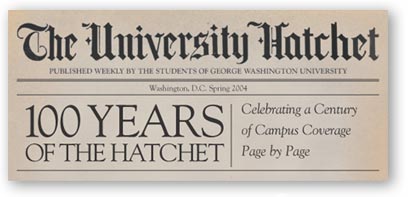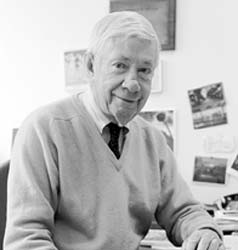|


By Laura Ewald
In this period in the broadening and strengthening of our Univer-sity, comes a new and wider field for a paper. This The University Hatchet shall endeavor to fill.

“Our aim is to make the paper more than ever a newspaper. We want the news of everything that is going on; of the faculty, of all our departments, classes, teams, fraternities, and we must have it…Our corps of Editors has been enlarged and the business management stands ready to do anything to realize our end. …
“…We ask, for our publication, for your publication, the support of the student body. Without it we must fail. With it we promise the best paper that the combined efforts of our editors and business management can produce.”
While these words were written by the newspaper staff more than 100 years ago, they speak for generations of its alumni. Hatchet journalists—whether in 1904 or 2004—are charged with the task of recording and reflecting the life they are living, the life of a GW student. Turning back the pages, we uncover a wealth of intelligent, provocative, and creative text. Each generation lends a unique voice while pursuing a common goal: Tell the GW story by working hard, asking the right questions, exploring all the angles, having fun, and learning from mistakes.
Start the Presses
|
_________________________________________
“I covered a variety of lively subjects for the Hatchet. For example, one evening in October 1950 I attended a talk by an official from Puerto Rico. The event turned into a wild shouting match among Puerto Rican nationalists—those demanding statehood and those favoring status quo on the island. On Nov. 1, 1950, a few days after my account of the ruckus appeared in the Hatchet, two Puerto Rican nationalists attempted to assas-sinate President Harry Truman in a shootout on Pennsylvania Avenue. A few days later the FBI called me, wanting more details from my Hatchet reporting.”
–former editor Walter Wingo, BA ’58, who spent 16 years as U.S. business editor for U.S. News & World Report
_________________________________________
|
Editor F.S. Hemmick, BL ’09, rolled out the first Hatchet, a 24-page weekly magazine, on Oct. 5, 1904—a time when the University itself was starting anew: “The present time is the critical period in our University’s life…Under a new name and with an awakened vigor; success seems to loom in sight.”
The fledgling publication adopted the maxim, “Hew to the Line and Cleve to the Truth,” though it primarily published campus happenings and voiced support for student endeavors.
The ’20s and ’30s were a time of steady growth for the University, with the completion of Corcoran and Stockton Halls paving the way for more classrooms and faculty offices.
Because the Hatchet was hard-pressed to cover such events as World War I and the Great Depression in a timely manner, the paper focused its attention on reporting campus growth and on covering GW sports. The wins and losses of the football and basketball teams took the front page of many issues, sharing the spotlight with what is considered straight news today. Colonials sports have always had an important place in the Hatchet. Over the years, highlights such as the 1957 Sun Bowl victory; the 1979 baseball team’s NCAA tournament win; women’s basketball appearances in the Sweet 16 in 1995 and the Elite Eight in 1997; and the men’s basketball appearance in the 1993 Sweet 16.
Staff editorials continually promoted school spirit and attendance at sporting and social events during the early decades. But the changing world forced the Hatchet to evolve. As the years passed, the paper grew in style and strength.
Wars and the Changing World
In the early 1940s, opinion pieces and editorials became a more prominent part of the publication—though for a time written under pseudonyms. Changes for the University meant changes for the newspaper and its coverage—students and alumni were called into service and some were lost in the line of duty; paper shortages meant smaller Hatchets; and the military utilized GW because of its proximity to the White House and the Pentagon.
In 1944, the Hatchet won the first of its many significant journalism honors, the Pacemaker award from the Associated Collegiate Press. The Hatchet also has been awarded the ACP’s Best of Show and the Mark of Excellence from the Society of Professional Journalists. Additionally, the paper also boasts four alumni who have gone on to win Pulitzer Prizes.
As the years went by, GW was touched by the Korean War and the nation’s movements toward racial and gender equality. Staff members were eager to become involved with and report on the world around them.
|
_________________________________________
 “Professor Puffenbarger was an outstanding mentor. He was always there and ready to give of himself. He helped me as a journalist when I was just starting out, and I’ll always be grateful for that. Every young journalist should be able to have someone like Charles Puffenbarger as a friend.” “Professor Puffenbarger was an outstanding mentor. He was always there and ready to give of himself. He helped me as a journalist when I was just starting out, and I’ll always be grateful for that. Every young journalist should be able to have someone like Charles Puffenbarger as a friend.”
–Carl Bernstein, whose coverage of the Watergate scandal for The Washington Post earned him a Pulitzer Prize
_________________________________________
Photo Claire Duggan
|
“I covered a variety of lively subjects for the Hatchet,” says former editor Walter Wingo, BA ’58, who spent 16 years as U.S. business editor for U.S. News & World Report. “For example, one evening in October 1950 I attended a talk by an official from Puerto Rico. The event turned into a wild shouting match among Puerto Rican nationalists—those demanding statehood and those favoring status quo on the island. On Nov. 1, 1950, a few days after my account of the ruckus appeared in the Hatchet, two Puerto Rican nationalists attempted to assassinate President Harry Truman in a shootout on Pennsylvania Avenue. A few days later the FBI called me, wanting more details from my Hatchet reporting.”
Center Stage
The 1970s and 1980s were decades of rapid social growth and change for GW and the world. Hatchet students were supported and challenged during this time by a professor who arrived in 1973, Charles Puffenbarger. Known as “Puff” to his students, he came to GW after working for newspapers including The Washington Evening Star and The Washington Post and teaching at the University of Illinois-Urbana. For 24 years, he was a friend and mentor to numerous Hatchet staff members until his death in 1997.
“Professor Puffenbarger was an out-standing mentor. He was always there and ready to give of himself. He helped me as a journalist when I was just starting out, and I’ll always be grateful for that,” says Carl Bernstein, whose coverage of the Watergate scandal for The Washington Post earned him a Pulitzer Prize. “Every young journalist should be able to have someone like Charles Puffenbarger as a friend.”
Later in the ’70s, outspoken against the Vietnam War, students from GW and across the country came to Washington to protest.
Hatchet reporters, having unique proximity to Washington landmarks, have always taken advantage of center stage by sending photographers and reporters to the scene of many historical events. On March 30, 1981, President Ronald Reagan was treated at GW Hospital after he was shot in an assassination attempt. Hatchet staff were among the corps of reporters briefed by GW Hospital officials.
Independent, In Color, and Online
|
_________________________________________
“Being independent means having more responsibilities. You’re accountable for your actions and your mistakes. You learn that there is always the next day, always a new paper to put out. You learn how to manage your peers, how to work with different kinds of people and personalities. Working for the Hatchet is learning to be a journalist…you learn about the entire process of putting out a publication, and that is invaluable experience.”
–former editor Becky Sher, BA ’99
_________________________________________
|
On July 1, 1993, the paper became independent of the University under then-editor Paul Connolly, BA ’94, and the support of GW President Stephen Joel Trachtenberg. The move was truly a milestone for the Hatchet, pushing the publication forward as a journalistic presence and a learning lab for students.
“Being independent means having more responsibilities. You’re accountable for your actions and your mistakes,” says former editor Becky Sher, BA ’99. “You learn that there is always the next day, always a new paper to put out. You learn how to manage your peers, how to work with different kinds of people and personalities. Working for the Hatchet is learning to be a journalist…you learn about the entire process of putting out a publication, and that is invaluable experience.”
In October 1994, after operating in the Marvin Center for years, the Hatchet moved into its new home, a townhouse at 2140 G Street.
Technology and determination drove the Hatchet to new levels: The paper released its first full-color issue and went online in 1996, and began publishing every edition online in 1997, making it possible to reach a worldwide audience for the first time.
A New Millennium
The hotly contested 2000 presidential election ushered in the new millennium, but the opinion pages—always filled with political banter—were soon filled with testaments of grief and remembrance after the Sept. 11, 2001, attacks on the United States. Hatchet reporters and photographers covered the first few days after the attacks from the grounds of the Pentagon. The Hatchet served as a medium for the student body to voice their thoughts and emotions about the tragic events and their impact on the world.
The paper’s legacy is celebrated with “From the Pages of The GW Hatchet: 100 Years of Student Journalists Covering Their World,” an exhibit in GW’s School of Media and Public Affairs Building open through May. The exhibit was presented by former Hatchet photographer and current University Relations photographer Claire Duggan, BA ’98, and Jody Tomesek, BA ’99, with the assistance of University Archivist G. David Anderson. On March 27, alumni shared memories and reconnected at a centennial gala in the Marvin Center Ballroom.
Back to top | Spring 2004 Table of Contents
|